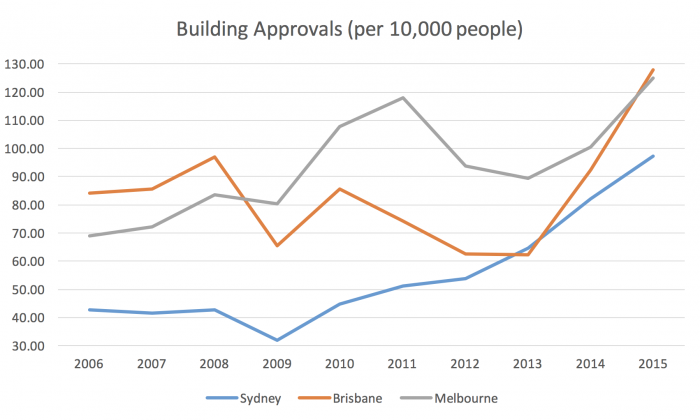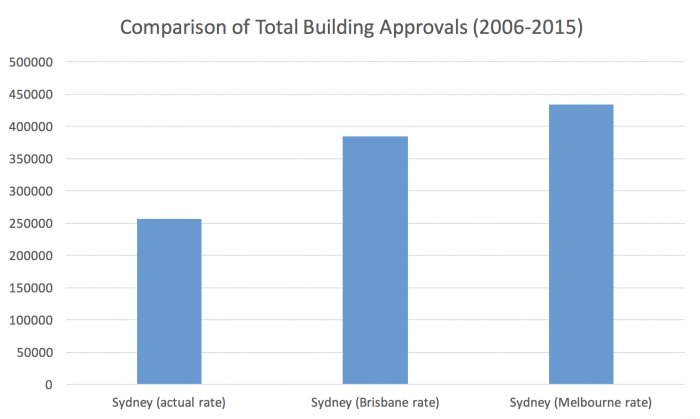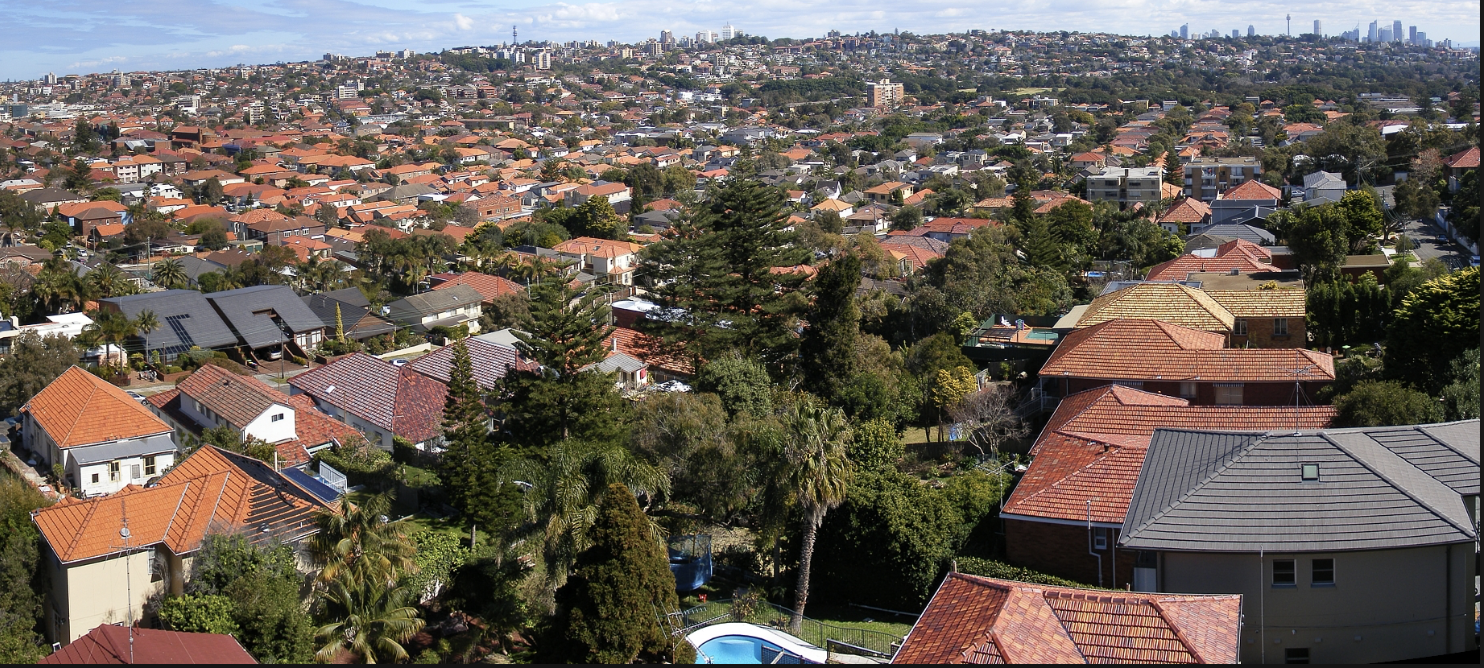The NSW Planning System must be reformed
If Sydney is to tackle its housing affordability issue, then more housing development must be approved. However, Sydney’s complex planning system is slowing down the development process. The approval for development includes a long list of vague considerations, which makes it difficult to get approval for development but also difficult for communities to raise genuine concerns against development. The uncertainty this creates undermines development opportunities and cements the divide between communities and developers. This reduces housing supply, putting upward pressure on property prices. The NSW government should consider reducing the scope of development that is subject to review and prioritising important policy principles such as access to affordable housing.
Sydney has been slow to approve new development
Despite record growth in Sydney, building approvals have consistently lagged Brisbane and Melbourne. In the decade until 2015, Sydney had an average of just 55.3 building approvals per 10,000 people; whereas Brisbane recorded 83.8 approvals per 10,000 people (around 50 per cent higher); and Melbourne recorded 94.0 (almost 70 per cent higher).[1]
Figure 1: Building Approvals per 10,000 people in Sydney, Melbourne and Brisbane
 3
3
Source: ABS
Although other factors have contributed to this difference, such as the geographical limitations on greenfield development on the fringes of Sydney, a large cause is NSW’s overly subjective planning laws.[2]
The lower approval rate represents a missed opportunity for the NSW economy. If Sydney had recorded the same rate of building approvals as Brisbane over the decade to 2015, then the NSW economy would have been around $61.4 billion (1.4 per cent) larger and around 128,000 more buildings would have been approved. If Sydney approved building at the rates recorded in Melbourne, then there would have been $85.9 billion (2.0 per cent) more economic activity and almost 176,000 more approvals during the same period.[3]
Figure 2: Comparison of Total Building Approvals

Source: ABS
The sluggish rate at which the New South Wales planning system is approving new buildings has ramifications for housing and liveability. Lower building approvals reduces the availability of new housing supply; pushing up the price of housing. Poor building approval rates also reduces access to infrastructure and services necessary for a good standard of living, reducing the benefits from agglomeration. For example, if further barriers are placed on building approvals, this could result in fewer childcare centres, medical facilities or local shopping centres that support small businesses.
The planning system must be flexible and clear
Achieving the right balance in our planning system is crucial. The planning system must be flexible enough to deal with the concerns of the community but also provide a sense of clarity so that developers are not turned away by the risks associated with legislative ambiguity. Ensuring that development is fairly assessed is important if major cities like Sydney can accommodate a growing population with world-class infrastructure and access to affordable housing.
The current NSW planning framework does not support these aims. Far too many development applications must undergo a complex merits assessment process. A merits assessment process is one where the development application must be determined against a series of criteria – such as the impact on the environment and social effects. Applying a merits assessment too broadly can increase the costs of development, reducing the number of development opportunities.
Most planning systems limit merits assessment for medium to larger scale development. Smaller developments (such as the building of a freestanding residential home) usually only need to comply with a prescribed building code. NSW has four types of development – prohibited, exempt, complying and development – that needs consent based on the merits review process.[4] This compares unfavourably to Queensland where regulations are simpler, as fewer types of development require consent.
The merits review criteria are too broad
The merits review criteria in NSW are set out in section 79C of the Environmental Planning and Assessment Act 1979 (NSW) (EP&A Act). The section contains five matters for consideration:
- The likely impact on the environment (natural and built) and social and economic impacts
- Suitability of site for development
- Any complying submissions made
- The public interest
- The provisions of an environment planning instrument (both current and proposed), a development control plan, planning agreements and relevant regulations
This section is broad and ambiguous. There is no weighting or hierarchy attached to these five matters. Some of the points of consideration are not well-defined and have been given a broad reading by the Courts.
Wide interpretations have meant that many development projects have not been approved because of the ease with which objections can be raised. The uncertainty of the legislation can also make it difficult for genuine community concerns to be raised against development. The uncertainty and cumbersome planning system adds to the cost of the development. The higher costs imposed by the legislation increases the costs and risks of development, reducing the supply of housing and worsening the housing affordability problem.
There are four problems with the current NSW legislation
The public interest needs to be defined
The legislation requires the ‘public interest’ to be considered when assessing development applications. The exact ambit of the public interest is not well-defined making the provision broad in scope. Many parties assert their own vested interest as the public interest. Some problematic aspects captured in the ‘public interest’ include community responses and ecologically sustainable development.
Community responses are part of the public interest on the basis that the overall objective of the EP&A Act is to provide more public participation in the planning process. [5]This makes the assessment of projects overly susceptible to community concerns. The only limiting factor that has been placed on this reading of the ‘public interest’ is that the fear must have a ‘rational basis’.[6] However, this can sometimes be difficult to determine before developers commence an application.
Principles of ecological sustainable development (ESD) can also be considered under the public interest. The definition incorporates aspects of the precautionary principle, inter-generational equity, principles of conservation and has recently been expanded to include the impacts of climate change.[7] Although ESD may not be as relevant for all construction development, larger construction projects may be significant enough to trigger ESD concerns. The inclusion of ESD in the public interest highlights how the merits review criteria continues to favour environmental considerations over economic ones. The problem is not that ESD is considered, but the way it is brought into the public interest consideration. Without further clarity of how ESD concerns should be raised, some groups may argue against development based on ESD issues even though the concerns do not actually relate to the development proposal. This makes approving development more difficult, reducing the supply of new housing.
The environment consideration should not be used to protect self-interest
The environmental consideration has diverged from genuinely protecting the natural environment to protecting ‘NIMBYism’ – the views, property prices and lifestyles of existing residents.[8] The legislation gives undue weight to community opposition to the new housing, particularly the construction of apartments in existing residential suburbs. The ability of existing residents to stop development, is pushing up the prices of homes and rents in Sydney and making it harder for young Sydneysiders to buy their first home.[9]
The concerns of residents are boosted by the broad interpretation of the term environment. The decision maker can be invited to consider the impact on both natural and built environments. ‘Environment’ is defined to include all aspects surrounding humans, whether as an individual or their ‘social groups’.[10] The broad definition allows a wide array of factors to be included in the environment consideration – from the impact on surrounding traffic, to aesthetic impacts on scenery and the neighbourhood.
The backlash to an affordable housing project in Parramatta in 2010 shows how residents can undermine significant development. The state government permitted the development of many affordable homes, some built in conjunction with the private sector. The new government reversed this policy in 2011 after significant opposition from the community with the local mayor electing to put up ‘Unsupported Development’ signs around the development. This is despite the fact Parramatta council had changed their local planning objectives to include access to affordable housing. Community backlash against the proposal was mainly due to traffic, overdevelopment, amenity and concerns about the process and the types of residents in affordable housing. Under the merits review scheme, the decision maker would need to consider all these various issues.[11]
There is no hierarchy in the criteria
The failure to order the importance of the merits review criteria harms those that support and oppose a development. Supporters may see their development application rejected on extremely narrow grounds. Opponents may have difficulty in convincing the decision maker that the grounds for objection is relevant.
Courts have unsuccessfully attempted to provide order to the factors. Earlier cases attempted to apply a ‘proper, genuine and realistic’ consideration requirement.[12] More recent cases have said that the relevant matter must be more than merely adverted to or given lip service.[13] However, neither of these approaches has provided useful guidance to decision makers on how to prioritise between the criteria.
The list of considerations is too broad
Over time, the merits review criteria have grown in number, particularly as the public interest consideration has expanded. The legislation must be an exhaustive list of considerations, so that all situations in different types of development are dealt with. The problem with a legislative list of merits review criteria is that it is a ‘one size fits all’ approach, and every development project becomes subject to the criteria set out in the legislation. There may be instances in which some aspects of the merits review criteria are not relevant to some parts of the city or for some types of development. The dispute between the Cheltenham community and Telstra over a new phone tower in 2006 provides evidence of this problem. Some members of the community argued against the tower based on radiation concerns. Although the court agreed those concerns had no foundation, Telstra was still forced to undergo lengthy litigation.[14]
Recommendations
Recommendation 1: Section 79C of the EP&A Act should incorporate a hierarchy
The simplest option for reform would be to create a hierarchy within Section 79C of the various matters. This would provide clarity of the relative importance of matters, to assist supporters and opponents of development to understand which factors are likely to be considered in a merits review. The equivalent Victorian legislation lists considerations that ‘must’ and those that ‘may’ be considered.[15] A similar structure could be easily adopted in NSW.
Recommendation 2: The NSW planning system should make greater use of code based assessments to reduce reliance on a subjective merits review
A movement to code based assessment would remove the inefficiencies of the merits review process. Code based assessment is where development is approved on the basis it complies with a code, helping developers and community members know the exact requirements for development to proceed. This removes unnecessary delays and appeals reducing the costs of development and speeding up availability of new housing.
NSW should adopt some of the aspects of the Queensland planning system which makes greater use of code based assessment. In Queensland, most development would be considered as ‘self-assessable’ or code assessed development;[16] and is permitted without the need for approval if it meets building codes, state regulations and regional plans.[17]
Although NSW has some form of code based assessment (known as ‘complying development’), it is not as widely used as in Queensland.[18] The equivalent complying development in NSW is generally limited to small scale development, whereas in Queensland, even some commercial development is code assessed.[19]
Code based assessment does not forego the need for community consultation for development. By setting out the standards of development, code based assessments can be an effective strategy to deal with concerns of communities and developers before disputes arise. This helps to speed up the delivery of development by avoiding lengthy disputes and expensive court battles.
Recommendation 3: The list of considerations in merits review should be narrowed and focused on important policy objectives
The current list of considerations is too diverse, preventing the planning system from focusing on the needs of Sydney and NSW and meeting long term planning goals set out in A Plan for Growing Sydney. With Sydney needing more housing supply and modern infrastructure, the merits review criteria should be re-written to be based around strategic policy issues.
In 2009, the COAG Reform Council suggested that planning systems should be re-orientated to address nationally significant policy issues such as: population growth and demographic change, productivity, connectivity, social inclusion, wellbeing and housing affordability.[20] The merits review criteria could be re-written to define social, economic and environmental concerns as those expressed in the COAG reform plan or other issues of state significance.
Emphasising policy issues in the merits review process would help combat ‘NIMBYism’ because it places concerns of residents in a broader context. Legislating and mandating a prioritisation of housing affordability and connectivity would help to ensure new housing is approved on grounds that meets the interests of the broader community, not just the interests of developers or residents.
Recommendation 4: NSW should move away from a statutory merits review list and allow local planning instruments to list the merits review considerations
In line with the original intention of the NSW planning system, merits review criteria could be scrapped from the legislation in favour of considerations outlined in statutory development controls.[21] By empowering statutory development controls, local councils and other local bodies could decide which considerations are important given their circumstances. This is the South Australian system, where the legislation contains no matters for assessable development but rather confers to the provisions of the appropriate Development Plan.[22]
One pitfall of this policy is that some statutory development controls may end up developing a more exhaustive list of merits review criteria. This problem could be avoided by having a more centralised development control that holds precedent over smaller development controls. The London Plan, a development strategy written by the Mayor of London, is an example of this approach. It dictates that the development strategies of the smaller thirty-two London councils must not conflict with the London Plan’s overall strategic priorities.
Combining local planning instruments and centralised development control would more effectively balance the expectations of the community with the interests of developers. The current model of broad-based considerations that apply to almost all development, means that local communities may have projects approved on a consideration ground that is not relevant for their local environment or economy.
If such a model was adopted, public submissions for most development projects would be limited to planning matters and matters identified in planning schemes. This would follow the Queensland approach for most impact assessable projects. For such projects, public submissions must address matters in the planning scheme, impacts on the natural environment or important local issues (such as traffic or parking).[23]
Conclusion
If Sydney is to address its housing affordability problem, then the planning system must support the approval of new homes. The current planning system is far too subjective, making it easy to refuse development and hard to determine community expectations for development. With Sydney having the lowest building approval rate of the three major Australian capital cities, and Queensland having recently reformed its planning system; NSW must reform its planning system to remain competitive with other states. Each year NSW fails to reform; it is missing out on up to $8.3 billion of economic activity and around 17,000 extra new buildings. NSW should consider narrowing the list of merits review considerations to strategic policy issues and making greater use of code based assessment.
References
[1] Australian Bureau of Statistics Cat No 8731.0.
[2] Wing Hsieh, David Norman and David Orsmond. 2012. ‘Supply side issues in the housing sector’, Reserve Bank of Australia <www.rba.gov.au/publications/bulletin/2012/sep/pdf/bu-0912-2.pdf>.
[3] Australian Bureau of Statistics Cat Nos 3101.0, 5220.0; Author’s Calculations.
[4] Environmental Planning and Assessment Act 1979 (NSW) s 76A.
[5] Telstra Corporation v Hornsby [2006] NSWLEC 133 (24 March 2006).
[6] Telstra Corporation v Hornsby [2006] NSWLEC 133 (24 March 2006), [107].
[7] Protection of the Environment Operations Act 1997 (NSW) s 6(2); Walker v Minister for Planning [2007] NSWLEC 741 (Biscoe J).
[8] Tim Williams and Sean Macken. 2011. ‘Homes for all: The 40 things we can do to improve supply and affordability’, The McKell Institute <mckellinstitute.org.au/wp-content/uploads/2012/04/McKell_HomesForAll_A4.pdf>.
[9] Peter Bentley and Sean Macken. 2012. McKell submission to: Sydney over the next 20 years, p 10 <mckellinstitute.org.au/wp-content/uploads/2012/07/McKell-Institute-submission-to-Sydney-over-the-next-20-years.pdf>.
[10] Environmental Planning and Assessment Act 1979 (NSW) s 4.
[11] Gethin Davison et al. 09/2013. ‘Understanding and addressing community opposition to affordable housing development’, Australian Housing and Urban Research Institute 211, p 43-67.
[12] Weal v Bathurst City Council (2000) 11 LGERA 181.
[13] Anderson v Director-General, Department of Environment and Climate Change [2008] NSWCA 337.
[14] Telstra Corporation v Hornsby [2006] NSWLEC 133 (24 March 2006).
[15] Planning and Environment Act 1987 (Vic) s 60.
[16] Sustainable Planning Act 2009 (Queensland) s 236-238.
[17] Sustainable Planning Act 2009 (Queensland) s 313.
[18] Environmental Planning and Assessment Act 1979 (NSW) s 76A(5); Productivity Commission
[19] Productivity Commission. 4/2011. ‘Performance Benchmarking of Australian Business Regulation: Planning, Zoning and Development Assessments’, Vol 1, p 87.
[20] Council of Australian Governments. 2009. ‘COAG Review of Capital City Strategic Planning Systems’ <www.linkplace.com.au/coag>.
[21] John Mant. 2007. ‘Submission to Corruption Risks in NSW Development Approval Process’ <johnmant.com/gallery/pdf_125396012078297.pdf>.
[22] Development Act 1993 (South Australia) s 33.
[23] Queensland Department of State Development, Infrastructure and Planning. 2/2013. ‘Development assessment—making a submission about a development application’, <www.dilgp.qld.gov.au/resources/factsheet/planning/da-making-submission.pdf>.


SOCIAL SHARE